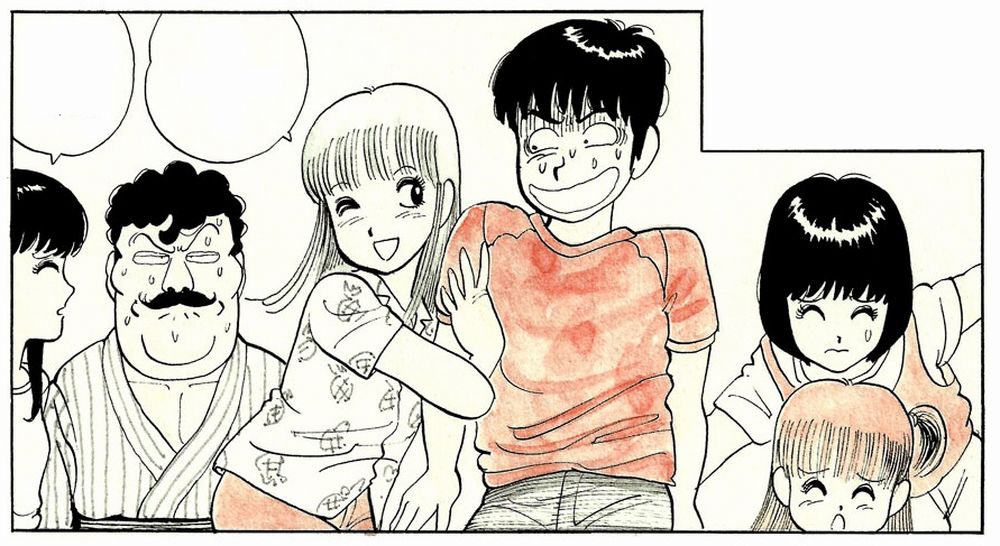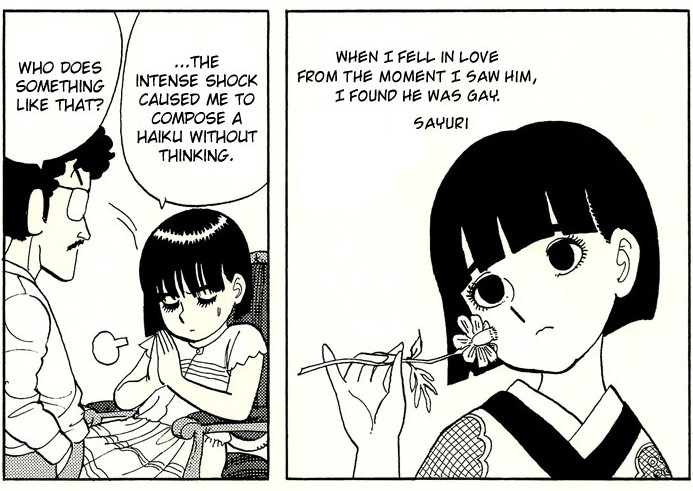Stop!! Hibari-kun as a Gender-Bender Manga

Stop!! Hibari-kun, penned by Hisashi Eguchi from 1981-1983, is a gag manga, published in shonen jump, that follows the lives of the Oozora household and their special guest Kousaku Sakamoto. Our protagonist, Kousaku, finds himself in a lot of standard gag manga hijinks after moving into a yakuza family home after the death of his mother. Not only the Oozora’s have to deal with the Yakuza life, but also find conflict dealing with Hibari’s gender identity, which comes as a shock to the main character, hijinks ensue.
Stop!! Hibari-Kun as Gender-Bender
Stop!! Hibari-kun is infamous, for many reasons. It’s influence on the “gender-bender” genre cannot be denied, whether or not you consider stories with transgender characters “gender-bender” or not is a whole different discussion. Smaller note about gender-bender and trans: While gender-bender may have some unsightly implications when used to describe stories with a focus on trans characters, it is a much better label than simply “crossdressing”. Why does Stop!! Hibari-kun have the “crossdressing” label on it’s myanimelist listing and The Bride Was A Boy does not? Much to think about. Although, I believe it lies in what makes a gender-bender story a gender-bender, what is gender-bender?
We can easily find out what makes gender-bender as a genre by analyzing the genre’s tropes within Stop!! Hibari-Kun. Stop!! Hibari-Kun is definitely a pioneer of the genre. It’s story takes on the main feature within the gender-bender genre, the focus on a character’s gender being “bended” in some way, whether this be through crossdressing, magic, or gender transition itself.
Note: I personally dislike labeling stories with transgender themes as either “gender-bender” or “crossdressing”, but for the sake of this article, Stop!! Hibari-kun is labeled in this way, not because of Hibari’s gender identity, but rather for the type of story the manga is.
Element #1: Ways those who know interact
The combination of gender-bender and gag-manga, a match made in heaven! Or rather, I just have the impression these elements go together, probably because the influence of this manga itself. The gender-bended effect of Hibari is often the butt of the jokes, or at least the conclusion of each chapter. Hibari’s presentation is treated as a laughing stock or a thing of perverted disgust by a majority of the cast, including our main character Kousaku. He often calls her a pervert, and worries that her perverted-ness will rub-off on him. Thanks, Kousaku-kun. Hibari’s father is disgraced by her appearance, often causing him to fall into “fits” where he has to be injected with dubious medicine by his yakuza lackeys for the attacks to stop. Hibari’s sister, Tsubame, often scolds Hibari, attempting to influence her to either act more manly, or act less defensive of her femininity, when it’s attacked, as Tsubame sees no point in Hibari defending these points if she is to be a man. Hibari’s youngest sister, Suzume, seems to simply view Hibari as female. These dynamics between Hibari, and those who live with her at home, make up this element in gender-bender stories, the way that those who “know” the “secret” interact with the “gender-bent” character. These relationships between the gender-bent and those who know, make up the narrative of the story and it’s jokes, in gender-bender stories.
Element #2: Ways those who don’t know interact
Hibari-chan is beautiful, stunning, and cute. She is skilled in both academics and sports, she is friendly and popular. This is how Hibari is viewed by those who do not know her “secret”. Hibari “poses” as a girl at school, meaning her classmates do not know her in any other way. Kousaku is shocked to find this out, and, at first, angered to realize he has to deal with Hibari being “allowed” to flirt with him and act girly, as he is the only one there to call her a pervert. Hibari’s sister, Tsubame, is equally distraught about this, complaining that she thinks Hibari perverted for acting this way at school. Hibari is unbothered by these critiques from those she lives with, and finds herself succeeding in her life as a girl at her school, via popularity and overall success. Shiina likes Hibari, along with most of the male population in the school, outside of Kousaku. The “popular girls” group of the school often finds themself jealous and skeptical of Hibari-chan’s appeal. How is she so beautiful? Why are all the boys infatuated with her? The “genderbent” character in these stories get treated as the “nice girl” archetype by the “popular girls”, causing them to act accordingly in the way the “popular girls” archetype antagonizes the “nice girl/heroine” archetype in other genres, such as romance dramas.
Element #3: Way the main character acts
Stop! Hibari-Kun shows/defines another trait of genderbend manga, the way the protagonist reacts to the genderbend. Kousaku, upon moving in with the family, finds himself disgusted and resistant to the implications of the “genderbend” (romance, perversion, potential social contagion, etc.), whilst simultaneously finds himself conflicted by his uncontrollable attraction to Hibari, the “genderbent” character, an element often found in the genderbend genre.
Element #4: The Tension, Those who know and those who don’t
The in crowd and the out crowd, a frequent point of tension and conflict in genderbend stories, usually coinciding with a location i.e. at out of school vs. in school. In the case of Stop!! Hibari-Kun, the tension is as follows, those who know (Hibari’s family, her father’s associates, Kousaku) being aligned with the location of Hibari’s household, those who don’t know (Notably classmates such as Shiina, Rie, Kotatsu, other classmates, etc.) aligned with the location of school or elsewhere that is not the Oozora household. This tension provides a source of conflict for each storyline in the manga, and this type of tension is what drives the storylines of every other gender-bender storyline, whether the entire series be within the gender bender genre, or just a chapter of a comedy series where a character cross dresses, the tension is what defines the gender bender genre, what makes the gender-bend a gender-bend. Characters who expect one thing while knowing/not knowing another thing to be true. The “those who know” crowd experience the (in the case of Stop!! Hibari-Kun, perceived) gender bend as the tension between what they expect, gender conformity, and what they perceive, gender nonconformity. Those in the “those who don’t know” crowd give the audience tension, in the form of dramatic irony, we know “the truth” about a character’s gender, whilst those who are clueless , are simply clueless. The gender bend allows us to experience the gender bend, with the “those who know crowd”, by giving us the experience through the dramatic irony we experience when viewing scenes with the “those who don’t know” crowd. In Stop!! Hibari-kun, the truth of the gender bend we, and the characters who “know”, experience is the fact Hibari was born male, yet in every situation of her life, presents female. Typical examples of gender bend manga often have the gender-bent character(s) as males, who present in female in every aspect, yet identify themselves as male. Hibari differs in this way, as a genderbent character, where she identifies as female and presents as female, despite her birth sex, however this does not emancipate her role in the story as the genderbent character.
Gender bender as a genre is not inherently fetishistic, although potential fetishistic elements can make themselves shown in other gender bender stories where the author insists on the gender-bend aspect being the character’s gender identity. Where Hibari-chan is female, despite her birth, she is not presented anything outside of the role of shounen jump heroine, in terms of female gender (lol, gender assigned jump heroine at birth). Characters in other gender bend stories where it is clearly a fetish element for the author and the readers (not judging or shaming) may have their gender consistently defined by the gender bend, repeated comments about whether they are a boy or girl, when really they get defined as “just CrossdresserA”, by other characters.
Note: This is different from the way real life people and other fictional characters choose to define themselves. This “he’s just CrossdresserA” way of describing a character is done by other characters in the story, and laughed at or made trivial by the subject, often CrossdresserA will not be given their own autonomy to define themselves, which can usually hint to us a fetish.
Note 2: Again, not shaming those with a fetish for aspects of crossdressing, just pointing out its element in stories. Hibari’s role as the genderbent in this gender bender story, does not define her gender identity as solely “genderbent”, in a way that could be similar to fetishistic genderbent stories, but rather as female. This does not emancipate her from being the genderbent character, but it also does not define her gender identity as “male” or “male* see terms and conditions, crossdresser”. Hibari is female, born male, and genderbent, all simultaneously, without an element of crossdressing gray area to define her.
Note: This does not mean that genderbent stories featuring trans characters are inherently not fetishistic; that could not be further from the truth, see trans fetishism. In my analysis, I am presenting the idea that there is no fetishism of crossdressing, gender-bend, etc. in Stop!! Hibari-Kun, at least not in the source material itself.
Element #5: The tension breaks, the reveal
The big reveal, manga’s response to gender reveals, the genderbend manga reveal. A point of conflict/struggle in a genderbender story is the fight against being “found out”. While some people know “the truth” about Hibari and her gender, a large swath of characters do not, and, as previously explained, this is what causes the genderbend effect itself. Enter Sayuri. Introduced in volume three, her purpose is that of an antagonist, who antagonizes Hibari and the rest of the characters in the know about Hibari’s situation by threatening to reveal this trait about Hibari. Upon finding out about Hibari’s secret, hearing news of it from her associate peeping on Hibari showering, Sayuri decides it is up to her to “save” Kousaku from a life as a “homo”. At the end of chapter 43, she brings this point up to Kousaku, which is easily interrupted by Hibari offering up her chest to be touched instead, with the end of the chapter focussed on them catching the guy who has been peeping around the Oozora property. This antagonistic reveal usually would have sparked drama, in the standard drama genderbend manga, but this is a gag manga so it ended here. Stop!! Hibari-kun, unlike many genderbend manga, lacks a true secret revealed moment, likely due to the early end to it’s serialization.
Stop!! Hibari-kun was a delightfully fun read, and Eguchi’s art was a gift to the eyes. Although many people nowadays may not feel comfortable with a trans character in the context of a stereotypical genderbend story, it still manages to explain to us that Hibari is different from a crossdresser, through her experiences and the way she explains herself. Stop!! Hibari-kun is also a treat from the past, a trans shonen jump heroine in a gender bend gag manga is really something that can only come from a bygone-era, and while the modern state of originality in anime and manga is tanking, and shonen jump is doing it’s best, I can only hope we get to see wacky, enjoyable, light-hearted stories, like this one, being serialized in major publications one day again.




